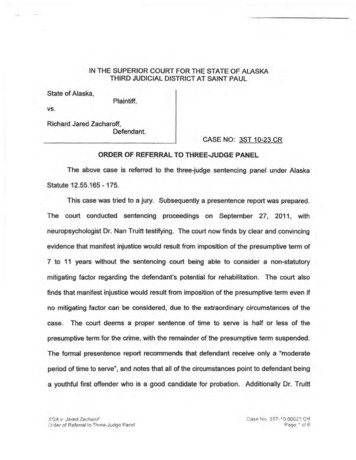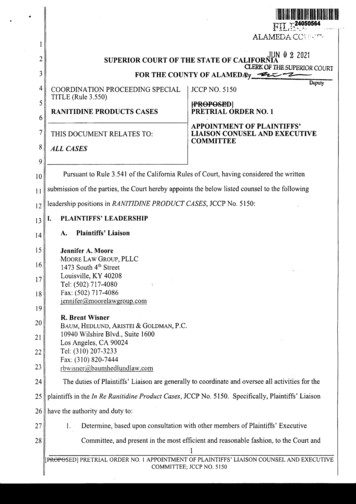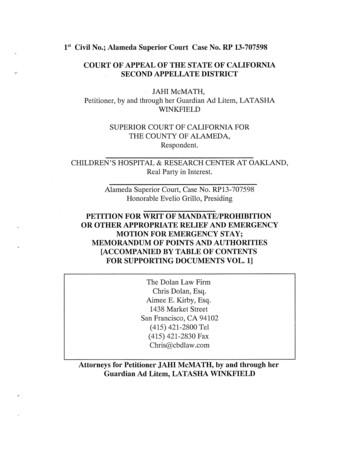
Transcription
IN THE SUPERIOR COURT FOR THE STATE OF ALASKATHIRD JUDICIAL DISTRICT AT SAINT PAULState of Alaska,Plaintiff,vs.Richard Jared Zacharoff,Defendant.CASE NO: 3ST 10-23 CRORDER OF REFERRAL TO THREE-JUDGE PANELThe above case is referred to the three-judge sentencing panel under AlaskaStatute 12.55.165 - 175.This case was tried to a jury. Subsequently a presentence report was prepared.The court conducted sentencing proceedings on September 27,2011, withneuropsychologist Dr. Nan Truitt testifying. The court now finds by clear and convincingevidence that manifest injustice would result from imposition of the presumptive term of7 to 11 years without the sentencing court being able to consider a non-statutorymitigating factor regarding the defendant's potential for rehabilitation. The court alsofinds that manifest injustice would result from imposition of the presumptive term even ifno mitigating factor can be considered, due to the extraordinary circumstances of thecase.The court deems a proper sentence of time to serve is half or less of thepresumptive term for the crime, with the remainder of the presumptive term suspended.The formal presentence report recommends that defendant receive only a "moderateperiod of time to serve", and notes that all of the circumstances point to defendant beinga youthful first offender who is a good candidate for probation. Additionally Dr. Truitt r)A v. Jated 7.ad1awf:)tder of Referral lo Three.Judge Par.elC ase:'lo 3ST-10.aoo;n CRPage ' cf 6
finds that the defendant has very good rehabilitation prospects, both subjective andobjective.The court directs that the record of the proceedings be transmitted to the State ofAlaska three-judge sentencing panel for consideration under AS 12.55.175.In sodoing, the court is not overlooking that several sentencing goals must be balancedwhen any sentence is considered.This court has no intention to ignore the otherChaney goals and focus only on rehabilitation. Rather, this referral seeks permissionfrom the three-judge panel to weigh and balance the defendant's good potential forrehabilitation along with the other goals, or to urge the three-judge panel to do so. Thecourt also asks the three-judge panel to consider the manifest injustice of the prescribedpresumptive term given the extraordinary circumstances of the crime, even though thecourt is well aware that the three-judge panel is not permitted to re-write the juvenilewaiver law. Smith v State,P.3d , Op. No. 2318, Alaska App., July 1, 2011 .The court made extensive oral findings on the record at the close of theproceedings September 27, 2011 . The court believes the three-judge panel will haveaccess to such transcript.The court noted in its oral findings that it had a uniqueopportunity during the three-week trial in this case to observe at length all of thefollowing-- the defendant, the victim, their families, and the community, including thecommunity's potential as a rehabilitation location for defendant. The facts that came outat trial also are important in suggesting these potentials and in underscoring theprobation officer's and Dr. Truitt's opinions about the defendant's good potential forrehabilitation.SOA v Jared Zacl1 ?rorOrder of Referral to Thre-e -Ju::JgE': P;:inelCasa l\J o. 3ST· 0-00023 CF P gg.3 2 -::? C::
The court at trial heard all of the substantial facts surrounding the crime and theindividuals involved. These facts are set forth in the presentence report. The factsshow that the assault resulted from a fairly "innocent" situation. Seventeen-year-oldJared Zacharof, the defendant, was home "minding his own business", visiting with twoother teen friends late in the evening. No drinking was involved. An elder sister, whowas visiting Saint Paul from out of town, came to the home intoxicated and wanting aride to a bonfire. The defendant was asked or told by his father to use his father's truckto give a ride to his sister. (The father did not want to go out himself, and he did notwant his intoxicated daughter to drive herself in his truck.) It turned out, unanticipatedby the father or the defendant, that the sister had a male companion with her (the victimin the case) who had not come into the house with the sister but was waiting outside thehouse to share the ride that the sister was getting.As soon as the ride started, the victim, who also was very intoxicated, repeatedlytaunted the defendant and his friends, who came along too. (The victim also had grownup in Saint Paul and knew the defendant and his girlfriend.) The teens, who includedthe defendant's girlfriend, were repeatedly and provocatively insulted, leading toshouting and to the defendant stopping the car, trying to get the intoxicated sister andmale companion out of the truck, refusing to give them a ride any further, given thedeterioration of the situation. During the posturing and fighting that resulted after thetruck was stopped, the defendant grabbed a metal pipe from the truck and struck thevictim in the head twice, doing serious injury.SOA v. Jtll d Zaclifl!O(Order of Referral to Three·J11dge PaneiCase No 3ST-10-0002:l CRPage .3 0f f i
This thoughtless and destructive action of the defendant was defended at trial asself-defense, or defense of third parties, but the jury did not accept this defense. To thecourt, it appeared the action of striking the victim so viciously to stop the victim'sbehavior was not unlike that of a small child biting a sibling because the child in the heatof the moment could think of no other way to try to attack/defend.The report and testimony of neuropsychologist Dr. Nan Truitt is comprehensiveand compelling.She concludes that the defendant has a very good potential forrehabilitation for a number of reasons. First, the defendant's aggression was reactive.Secondly, he has learned already from this incident, and now he is both physically andmentally more mature. Third, he has substantial family and community support. Fourth,he does not have serious issues with addiction, anti-social personality, adolescentconduct disorder or the like.Finally, but not less importantly, he is respectful ofauthority, not a bully, and not fascinated with guns or violence.He is viewed as just a"nice kid" with borderline MMR (Mild Mental Retardation) issues, perhaps related toFASO. (He may suffer to some degree from Fetal Alcohol Spectrum Disorders, althoughhe attended school with his peers without any extreme social problems, and whileincarcerated post-trial completed his GED.) He appears to adapt well and to learnsocial skills with normal behavior modification techniques, although the academic partsof school are a struggle for him.Dr. Truitt's report and testimony underscore theotherwise good nature and promise the defendant has as an individual in his communityand in our society.SOA v. Jared ZacharofOrder of Referral to Three-,Judge PanelCase No 3ST-10-00023 CRPage 1 of 6
The record is clear and convincing that defendant is an excellent candidate forprobation services. He does not need to be incarcerated for 7 years to get motivated tochange or to learn that his reaction of using the metal pipe in the situation wasextremely wrong. The court notes that three-and-a-half years in the life of a 17 year oldis 20% of his life, whereas the presumptive sentence of 7 years in the life of a 35 yearold is the same 20%. In terms of how much time is warranted to deter an offender orreaffirm societal norms, such percentage consideration is relevant.The court also deems restitution very worthy of consideration in circumstanceslike those in this case. The victim is seeking restitution for time lost from work, andperhaps other losses. (His medical expenses were covered.) The community is small,and whether defendant is paying restitution will be noticed, and will be part of thehealing. The defendant now has completed high school and can work. He is describedas a diligent worker from a community with work opportunities. The sooner he is onprobation, the sooner he can go to work to compensate his victim.The three-judge panel exists to address extraordinary circumstances andmanifest injustice. This referral is premised both on the finding that the sentencing courtshould be able to consider the defendant's excellent potential for rehabilitation, and onthe finding that even without considering this potential for rehabilitation , "manifestinjustice" would result from sentencing this young, never before convicted, defendant to7 to 11 years, given the circumstances as to how the crime came about. All of the goalsof sentencing are more than adequately met by a sentence of half that amount, or less,with the rest of the time suspended and the defendant placed on supervised probationSOA v. Jared ZacliarofD rder of Referral io Three-.ludge PanelCage No 3ST- 10-00023 CRP3ge :3 -:if G
The A laska Constitution deems that sentences shall be based on the principal ofreformation and the need to protect the public. A probationary type of sentence meetsthose goals here. All the professionals involved in the case so far believe the defendantshould receive a probationary type of sentence more than a lengthy sentence toincarceration.Dated at·B (vv,e.r , Alaska this :J 1day of September, 2011.B Superior Court Judge Pro T emq\Ie. l \.)Vfr lAl"c\,JI certify that onL,.q"'Ia copy of this order was mailed or de,vered t :]'. -u ('t)'0Phel&-0, f"ifJOClerk:C:LyY"\SOA v. Jared Zacharoi:)rd&r of Referral to Three-.J,1dqe PanelC?.S"! No 3ST -1 0-00023 C 1 ?age G 0f r.
presumptive term for the crime, with the remainder of the presumptive term suspended. . anti-social personality, adolescent conduct disorder or the like. Finally, but not less importantly, he is respectful of authority, not a bully, and not fascinated with guns or violence. He is viewed as just a "nice k











